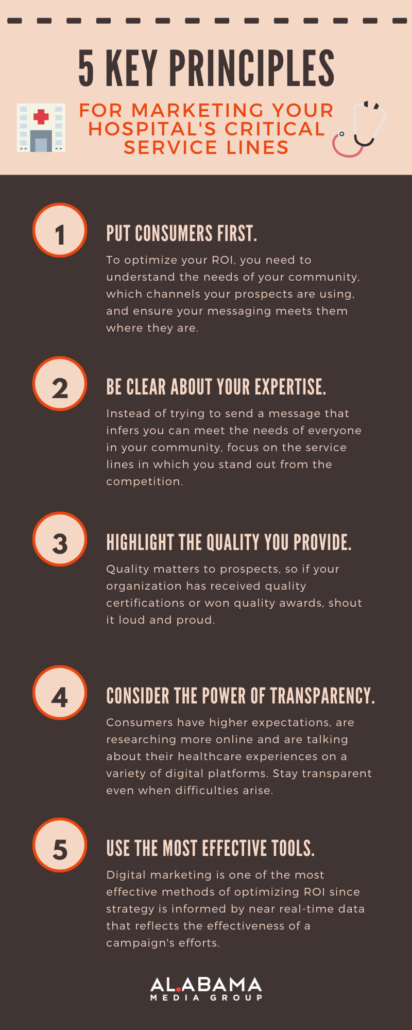5 Keys to Marketing Your Hospital’s Critical Service Lines
The passage of the Affordable Care Act (ACA) in 2010 changed everything for hospital strategic planning. Organizations which previously counted on being jacks-of-all-trades for their communities were suddenly faced with the urgent need to shift from offering generalized to specialized patient care services. In such an environment, it’s essential that hospitals find a way to effectively market their critical service lines, and the five keys covered here can help you do that.
The pivot to specialization within hospital systems
In “Hospital Specialization: Benefits-Focused Product Line Planning,” Steven R. Eastaugh, PhD highlights how market forces which include the adoption of a value-based model of care have led to a need for hospitals to increasingly specialize their service lines. This framework of specialization is often referred to as “focused factories”—which are highly specialized departments within a larger hospital system.
This shift to a focus on population health management through specialization is geared toward optimizing the quality of care while reducing costs. Eastaugh notes that these trends toward specialization are fueled by the prevalence of physician specialists—as well as the growth of condition-specific advocacy groups which seek to secure better coverage by health care plans.
Additionally, the explosion of technology and the digital health revolution in recent years have fueled the consumerization of healthcare which has led to more informed patients who have expectations for improved access to the specific types of quality care they need. The critical service lines your organization provides are essential to helping them get it—but they need to know how what they need matches the specific offerings your organization can provide.
Bridging the marketing gap
There are a variety of issues to consider when bridging the marketing gap so the prospects you’re trying to reach get the message about your critical service line offerings. Here are five key principles to keep in mind:
- Put consumers first. Understanding your local and regional communities is critical to meeting their needs for care and ensuring they know how your organization can meet them. Once you have such insights in hand, ensuring they have easy access to the right specialized services provided at the highest levels of quality is essential. This is also true when it comes to delivering your marketing message. To optimize your ROI, you need to understand the needs of your community, which channels your prospects are using, and ensure your messaging meets them where they are.
- Be clear about your expertise. Instead of trying to send a message that infers you can meet the needs of everyone in your community, focus on the service lines in which you stand out from the competition. In addition to sending a message of confidence to your prospects, Eastaugh says that “So-called ‘centers of excellence’ may assist hospitals in gaining access to capital (donors prefer to give to centers for treatment of a particular disease or ailment).”
- Highlight the quality you provide. Quality matters to prospects, so if your organization has received quality certifications or won quality awards, brag about it. As Eastaugh notes, “In a decade where…hospitals are now experiencing fiscal troubles, no point of differentiation is likely to prove more powerful than quality. … For all hospital managers, quality and marketing are becoming increasingly important issues. Developing areas of specialization can bring prestige to a hospital and serve as a magnet for attracting more patients.”
- Consider the power of transparency. In today’s accountable-care world of healthcare, consumers have higher expectations, are researching more online, and are talking about their healthcare experiences on a variety of digital platforms. This may be beneficial when the feedback is positive, but if it’s not, it can be difficult for an organization to respond. Health Catalyst describes the journey of one hospital that experienced the power of transparency by using a system that allowed them to post results on their own site.
- Use the most effective systems and tools. This is certainly true in the clinical setting to ensure the highest quality of care, and it’s true when it comes to effective marketing to tout the unique services you have to offer. Digital marketing is one of the most effective methods of optimizing an organization’s ROI, since strategy is informed by near real-time data that reflects the effectiveness of a campaign’s efforts. If adjustments are needed, digital marketing tools provide the agility needed to help hospitals achieve the marketing outcomes they need to attract the right patients to their critical service line offerings in order to optimize patient care and support the bottom line.
One of the most important aspects of achieving effective marketing results is in finding the right digital marketing partner to help you do it. AMG owns the largest healthcare audience in Alabama through our own online sites and publications, and our HIPPA-compliant tools allow us to gain unique insights into the local patient market through a disease-specific lens. If you’d like to learn more about how we can help your organization, let’s talk.




